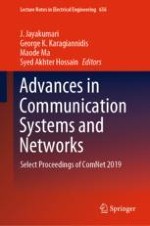This book presents the selected peer-reviewed papers from the International Conference on Communication Systems and Networks (ComNet) 2019. Highlighting the latest findings, ideas, developments and applications in all areas of advanced communication systems and networking, it covers a variety of topics, including next-generation wireless technologies such as 5G, new hardware platforms, antenna design, applications of artificial intelligence (AI), signal processing and optimization techniques. Given its scope, this book can be useful for beginners, researchers and professionals working in wireless communication and networks, and other allied fields.
